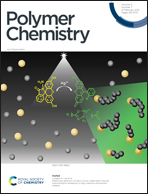Efficient white light-emitting polymers from dual thermally activated delayed fluorescence chromophores for non-doped solution processed white electroluminescent devices†
Abstract
Developing high-performance pure white-light emissive thermally activated delayed fluorescence (TADF) polymers, which is still challenging, is of great importance for realizing highly efficient, large-scale and low-cost white organic light-emitting diodes (white OLEDs), since they show several advantages, including ease of large-area fabrication via the solution process. In this work, we designed and synthesized a series of conjugated TADF copolymers, PCPSTTx (x = 1, 3, 5 and 10) with a backbone-donor/pendant-acceptor architecture, in which two TADF small molecules of bis[4-(3,6-di-tert-butylcarbazole)phenyl]sulfone (DTC-DPS) as a blue light emitter and 2-(4-(diphenylamino)-phenyl)-9H-thioxanthen-9-one-10,10-dioxide (TXO-TPA) as an orange light emitter were covalently linked with the conjugated backbone of N-9′-heptadecanyl-carbazole through their donor fragment. It is verified that the TADF features can be achieved by copolymers effectively from both TADF moieties. By adjusting the TXO-TPA content (x), the emission colors of the copolymers can be successfully tuned from yellow to pure white light. In particular, the non-doped OLEDs fabricated with PCPSTT1 exhibited stable pure white emission with a maximum luminance efficiency of 9.13 cd A−1, maximum external quantum efficiency of 4.17%, and CIE coordinates of (0.32, 0.35).



 Please wait while we load your content...
Please wait while we load your content...